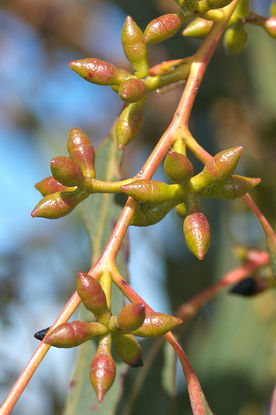
Strategic tree and forest establishment and regeneration on the Southern Tablelands
Eucalyptus bridgesiana
Apple Box
MYRTACEAE
Native range: Vic, ACT, NSW, Qld Height: 15-20 m Width: 10-15 m Flowering: Summer to early autumn Fruiting: Summer to autumn Light: Full sun Growth rate: Moderate Soils: Free-draining loam, clay loam and alluvial soils Drought tolerance: Moderate Landscape position: Lower slopes and flats in drier sites, hills in wetter sites. Rainfall range: 550 – 1000 mm Benefits: Apple Box (Eucalyptus bridgesiana) is a large, long-lived native evergreen tree with a spreading crown, attractive grey box bark, arching branches and bright, glossy leaves. It is moderately drought and very cold, frost and wind tolerant, doing best on well-drained heavier soils. The buds and fruit are in groups of seven (not always seen due to abortion of buds or capsules), the bark is rough, coloured dark grey with white patches. The immature leaves are opposite each other on the stem, with scalloped edges. Apple Box is a useful shelterbelt species, providing medium- and upper-level cover and shade. It can used to control erosion in gullies and areas with cold air drainage. In landscaping plantings, mature trees add an impressive, statuesque quality, with attractive branches that sometimes reach to the ground. Can be used as a paddock tree as it will withstand low levels of compaction but should be protected from trampling where possible. Apple Box are excellent habitat for wildlife. They flower profusely, offering nectar and pollen to insects and birds. The seed is eaten by birds. Mature trees have good hollows that are nesting sites for birds and native marsupials. It produces excellent, sweet, strong flavoured honey, but flowering does not occur every year, tending to be biennial or every four years. The pollen is high quality, rich in protein, and good pre-winter feed for honeybee hives. The timber is not very strong, and not durable outdoors and therefore not used in construction. The firewood is acceptable but not excellent. Drawbacks: Too large for domestic gardens. Can be subject to mistletoe infestations and psyllid attack. Uses: Ornamental and landscaping use in parklands and gardens Shelterbelts Produces excellent honey Habitat for native biodiversity Specialty timber used in cabinetry and fine craft items Timber for firewood Propagation: From seed. Weed risk: None Future climate risks: Irregular flowering, canopy thinning and slow growth during extended dry years and heatwaves. Branch dieback, limb drop and death of trees in dry, exposed sites. Increase of disease and insect attack due to uneven climate. References AVH (2022). The Australasian Virtual Herbarium, Council of Heads of Australasian Herbaria –https://avh.chah.org.au Beuhne, F.R., The Honey Flora of Victoria (1922) – https://shorturl.at/jkB13 PlantNET (The NSW Plant Information Network System). Royal Botanic Gardens and Domain Trust, Sydney – https://shorturl.at/CLX27 TreeProject – https://shorturl.at/zV067 Woolshed Thurgoona Landcare Group website – https://shorturl.at/iSTU0

























